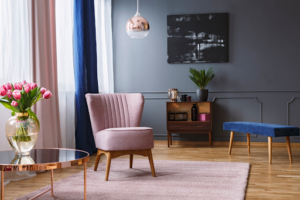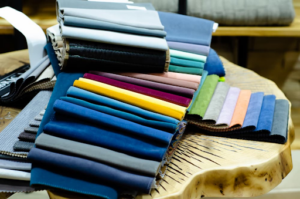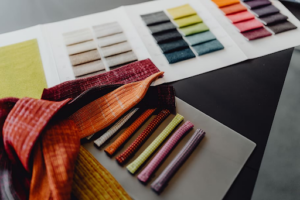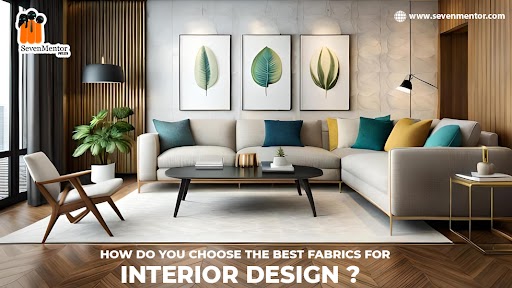How Do You Choose the Best Fabrics for Interior Design?
The process of interior design starts with a problem and ends with a design solution. Interior design is more than just attractive pillows and paint colors; it is a combination of creativity and functionality. For this reason, every component of a design plan is valuable. Knowing that each design decision will have an impact on the overall design, a great designer strives for a sense of balance and harmony. Which leads us to the cloth! Fabric is an important part of any design and should not be taken lightly. Explore expert tips on How Do You Choose the Best Fabrics for Interior Design?

Things to consider when selecting an appropriate fabric
First and initially a designer must have a fundamental awareness of the various types of materials that are suitable and available for interiors. There are numerous possibilities available, but from the standpoint of a designer, the decision must be made based on aesthetics, practicality, and price limits. Here are a few frequent favorites for a designer’s fabric stash:
For Free, Demo classes Call: 020 71171757
Registration Link: Interior Design course in Pune!
Leather:
This can be hard, soft, or suede and is an excellent choice for furniture and upholstery. Leather and faux leather are not only robust and long-lasting, but they may also be extremely stylish. It is a highly adaptable material that can be used anywhere from sitting to table tops, curtains, rugs, and cushions, and the list goes on.
Silk:
is an exquisite, high-quality fabric that should be treated with care. It’s a lovely complement to a formal environment, but the fabric is delicate and easily destroyed. Silk is best suited for curtains, wall art, and lampshades because it lacks the resilience required for hard-wearing areas.
Cotton:
Cotton is a breathable and adaptable natural fiber that may be used in a variety of applications, including apparel and interior design. Cotton works particularly well in children’s bedrooms and common areas.
Rayon:
If you don’t have the funds for silk but still want to make a beautiful statement, Rayon is a great option. It resembles silk but is more durable and hardworking, making it suited for draperies and upholstery applications.
Velvet:
is the go-to for grandeur. Velvet has a wonderful tactile quality and may create a sensual and rich atmosphere. Velvet’s appeal swings, yet it always exudes refinement.
Polyester:
When mixed, polyester stands out for its toughness, making it excellent for hard-wearing settings such as children’s bedrooms.
Microfiber:
is a modern and fluffy material that is both economical and easy to maintain, making it a popular choice in contemporary designs.
Wool:
Wool is remarkably adaptive, acting as both a natural insulator and a sound absorber. Its texture and durability make it a popular material for carpets, throws, and upholstery, especially in colder regions or comfortable settings.
However, there are some more variables to consider when selecting your fabrics. Try to combine your vision with practicality and budget, and consider the overall design and how each aspect will connect with the others. You might love silk, for example, but there’s no use in spending the entire budget on a silk drape that will be damaged by young children as soon as they get their sticky hands on it. Each room will serve a purpose, and an interior designer must understand how it will be used and by whom. Is it a casual lounge, a formal dining room, or a playroom for kids? A bedroom, for example, may require soft, luxurious fabrics, whereas a television room will benefit from more durable materials that can withstand wear and tear.

For Free, Demo classes Call: 020 71171757
Registration Link: Click Here!
Consider durability when selecting fabrics
Durability
Whether creating a home, a hotel, or a cafe, people will interact with the spaces, and they will leave their mark. Durability in fabric refers to the lifetime of both usability and aesthetics. Sturdy textiles such as microfiber, canvas, and certain leathers can resist repeated use.
Maintenance
Maintenance is the price you pay for fabrics that are not durable. Certain textiles require more attention than others. Silk, for example, is sun-sensitive and may require frequent dry cleaning, making it unsuitable for sunrooms or spaces frequented by youngsters or pets. In contrast, synthetic materials are easier to clean and maintain.
Texture
This is a design choice that can greatly enhance a scheme. Texture adds sensory value to a place while also giving a visually appealing edge to a potentially flat style. Balancing different textures can bring a place to life by giving depth and intricacy.
Colour & Pattern
It is widely acknowledged that the use of color in a room can have an emotional impact on a person. Neutral tones can be relaxing, whilst vibrant colors can make you feel stimulated. Consider the users of the place and select a palette accordingly.
When it comes to patterns, size does matter! Large patterns might be intimidating in a small space, but they can create a majestic and grandiose atmosphere in a bigger room. However, tiny patterns can have a significant impact on a room.
Test
Samples are a valuable resource for designers. The feel of a fabric in your hands can influence where and how it is utilized. fabric may appear soft in an image, but if fabric is itchy or gritty, it is not suitable for upholstering a living room sofa. Colors, patterns, and texture should all be examined. Take the sample to the space you’re designing and look at it at different times of day. Showroom lighting or online photographs are frequently inaccurate representations of what appears in person.
Environmental and health factors
Seek out textiles that are organic, recycled, or responsibly sourced. Textile waste and landfills are major environmental issues, but designers are becoming increasingly cautious about their choices. Some fabrics are treated with chemicals that release VOCs (volatile organic compounds), so do your homework before purchasing. There are numerous beautiful and sustainable solutions available.
For Free, Demo classes Call: 020 71171757
Registration Link: Click Here!
Budget
Many initiatives are limited by a budget, but there are effective ways to utilize your funds. Sometimes designers believe that a cheaper fabric option is a better alternative for a design, but keep in mind that in some cases, investing in high-quality fabric can save money in the long run, particularly for pieces that will be used regularly.
Client
When it comes to fabrics, there are numerous processes and countless alternatives, but a designer must also believe in their own abilities and, more significantly, confer with the client. If your client has requested a specific fabric, unless you believe it is a bad selection, there’s a strong probability it will make them pleased every time they visit the space.
Fabric, color, texture, pattern, space, light, functionality—the list goes on. There are several design aspects that must work together in harmony, and cloth is an essential component of this jigsaw. As you embark on your journey through swathes and rolls of fabric, these suggestions should help you make informed decisions and create a beautiful, useful, and stylish room as an interior designer.
Do visit our channel to learn more: Click Here

Author:-
Kalyani Bhavsar
© Copyright 2023 | SevenMentor Pvt Ltd.
Call the Trainer and Book your free demo Class for Interior Designing Call now!!!

